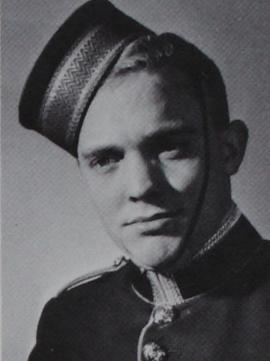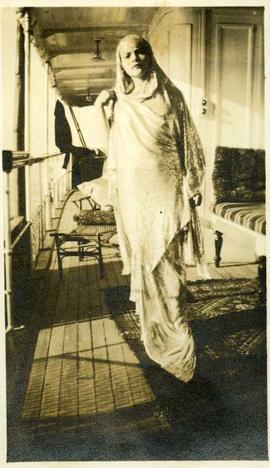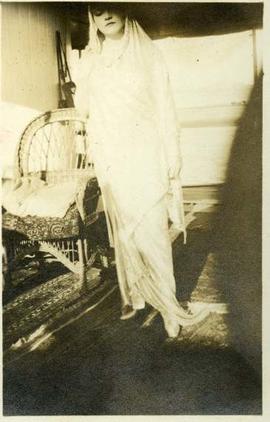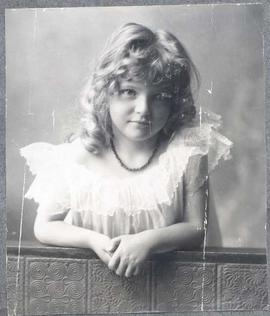Preben Ejgil Kaersvang attended Canadian Services College Royal Roads from 1962-1964. Born in 1943, he joined the 32 Utility squadron of the Royal Canadian Navy, division VS880, a fixed wing operational squadron of 12 pilots. As a naval pilot, he was killed in a training exercise at CFB Downsview, ON on 2 February 1968.
James Jr., known as Boy by his immediate family, and born in January 1894, is dressed the same as his sister, Kathleen, born in 1891. In the 19th century, boys and girls were dressed alike until aged about 4. At this time, boys would have a 'breeching ceremony' where their hair would be cut short and they would wear their first pair of trousers. Although less common by the end of the 1800s, the Dunsmuir family followed this tradition.
Kathleen Dunsmuir as young woman, posed seated, dressed w/ lace collar and cuffs, pearl necklace. Sepia tone portrait
Kathleen Dunsmuir Humphreys' Beverly Hills residence, car parked in front. Caption reads: "Front of house."
Kathleen Dunsmuir Humphreys' Beverly Hills residence, showing gate leading from garden. Caption on back: "Back of house."
Kathleen Dunsmuir Humphreys, in snow suit, cap and boots. Caption on face of the negative reads "Arrowhead-Jan 2-'32"
Kathleen and Muriel each had photos taken in the same outfit at Oscar Mayer Studios. Copies of this image exist in different Dunsmuir family albums.
Robert William Kostiuk attended Canadian Services College Royal Roads from 1949-1951. Born in 1929, he served with the Royal Canadian Air Force. He was stationed with 444 Fighter Squadron at Baden-Soellingen, Germany, and was killed on 12 June, 1955 when his F-86 Sabre aircraft rolled while turning on a final approach to land.
In 1913, James Dunsmuir acquired a wooden structure created by the Kwakwaka'wakw people to be used as a gate entrance to the Japanese garden. The sculpture was carved from western red cedar and had three upright pieces joined by a horizontal lintel. The picture shows their position on the grounds of Hatley Park. The sculpture was located at the Dunsmuir property from 1913-1938. The posts were originally intended for the inside of a house in Dzawadi and were carved around 1884, but the house was never completed and the house posts were left until they were bought by a collector who later sold them to James Dunsmuir. Dzawadi is about 100km northeast of Alert Bay and within the traditional territory of the Da’naxda’xw Awaetlala First Nation.
In 1938, after Laura Dunsmuir’s death, the posts were sold to George Heye, who was a well-known collector of anthropological and archeological artefacts of the Americas. The posts were part of the collection at the Museum of the American Indian in New York until 1975 when they were bought by the National Museum of Canada.
A conservator's report from the Canadian museum shows that the posts were damaged before they were positioned at Hatley Park. Careful restoration work had occurred when the house posts were relocated to the Dunsmuir estate. New wood pieces had been skillfully added to replace damage caused by a grass fire in its original location. A second, less careful restoration took place sometime after 1936, provable by the fact that pages of newspaper from that year were found used as filling material under a crude plaster and papier mache repair.
In 1913, James Dunsmuir acquired a wooden structure created by the Kwakwaka'wakw people to be used as a gate entrance to the Japanese garden. The sculpture was carved from western red cedar and had three upright pieces joined by a horizontal lintel. The picture shows their position on the grounds of Hatley Park. The sculpture was located at the Dunsmuir property from 1913-1938. The posts were originally intended for the inside of a house in Dzawadi and were carved around 1884, but the house was never completed and the house posts were left until they were bought by a collector who later sold them to James Dunsmuir. Dzawadi is about 100km northeast of Alert Bay and within the traditional territory of the Da’naxda’xw Awaetlala First Nation.
In 1938, after Laura Dunsmuir’s death, the posts were sold to George Heye, who was a well-known collector of anthropological and archeological artefacts of the Americas. The posts were part of the collection at the Museum of the American Indian in New York until 1975 when they were bought by the National Museum of Canada.
A conservator's report from the Canadian museum shows that the posts were damaged before they were positioned at Hatley Park. Careful restoration work had occurred when the house posts were relocated to the Dunsmuir estate. New wood pieces had been skillfully added to replace damage caused by a grass fire in its original location. A second, less careful restoration took place sometime after 1936, provable by the fact that pages of newspaper from that year were found used as filling material under a crude plaster and papier mache repair.
In 1913, James Dunsmuir acquired a wooden structure created by the Kwakwaka'wakw people to be used as a gate entrance to the Japanese garden. The sculpture was carved from western red cedar and had three upright pieces joined by a horizontal lintel. The sculpture was located at the Dunsmuir property from 1913-1938. The posts were originally intended for the inside of a house in Dzawadi and were carved around 1884, but the house was never completed and the house posts were left until they were bought by a collector who later sold them to James Dunsmuir. Dzawadi is about 100km northeast of Alert Bay and within the traditional territory of the Da’naxda’xw Awaetlala First Nation. This images shows the house posts in their original location.
In 1938, after Laura Dunsmuir’s death, the posts were sold to George Heye, who was a well-known collector of anthropological and archeological artefacts of the Americas. The posts were part of the collection at the Museum of the American Indian in New York until 1975 when they were bought by the National Museum of Canada.
A conservator's report from the Canadian museum shows that the posts were damaged before they were positioned at Hatley Park. Careful restoration work had occurred when the house posts were relocated to the Dunsmuir estate. New wood pieces had been skillfully added to replace damage caused by a grass fire in its original location. A second, less careful restoration took place sometime after 1936, provable by the fact that pages of newspaper from that year were found used as filling material under a crude plaster and papier mache repair.
The images are from Laura Catterall Ferguson’s family album. The images mostly concern the construction of Hatley Park and the Catterall’s residence on the property during construction. Head contractor Thomas Catterall’s son, Harry, also worked on the project and lived on site with his wife Ada (Gladding) Catterall. Their two young children, Helen and Tommie were also on site. Tommie Catterall also worked for the Dunsmuirs at Hatley Park as a general handyman in the 1930s and there is an oral history interview with this Tom Catterall available in the archives. The photocopied album pages from where the images were scanned contain useful contextual information about the family and the timeline for construction.
Catterall FamilyPhotos of Dunsmuir family members at Hatley Park and other locations. Some formal portrait photos are included.
Dunsmuir FamilyLa Salle Flight, 1956 Hessin, front row centre



















